Goodyear, AZ Pollen and Allergy Report for Summer 2023
Pollen Allergy Trends in Goodyear, AZ
When is pollen lowest in Goodyear, AZ?

February
Lowest month total PPM
Avg. PPM
When is pollen highest in Goodyear, AZ?

March
Highest month total PPM
Avg. PPM
How does pollen in Goodyear, AZ compare to Arizona?
Goodyear has a higher average PPM than the state of Arizona.
Goodyear yearly avg PPM:
Arizona yearly avg PPM:
How does pollen in Goodyear, AZ compare to the USA?
Goodyear has a lower average PPM than the USA.
Goodyear yearly avg PPM:
USA yearly avg PPM:
Is pollen worse this year in Goodyear, AZ?
Spring 2023 was better than spring 2022.
Spring 2023 PPM:
Spring 2022 PPM:
Average PPM in Goodyear, AZ
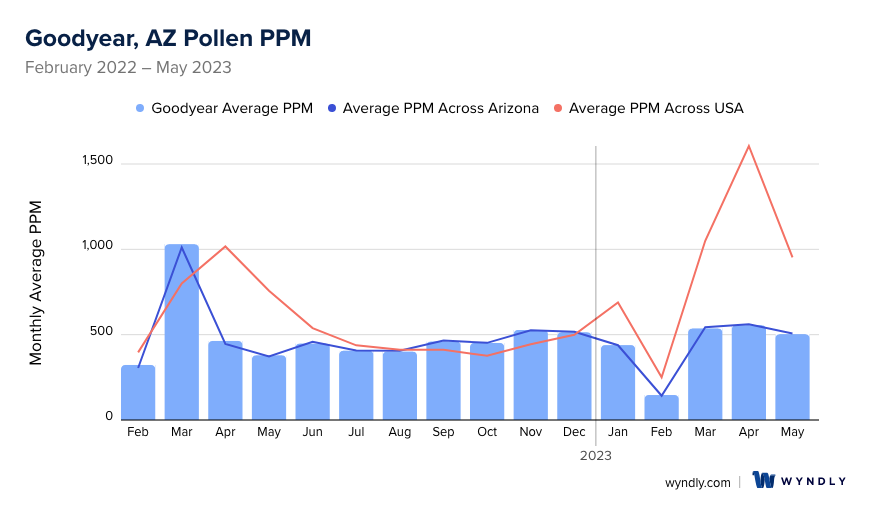
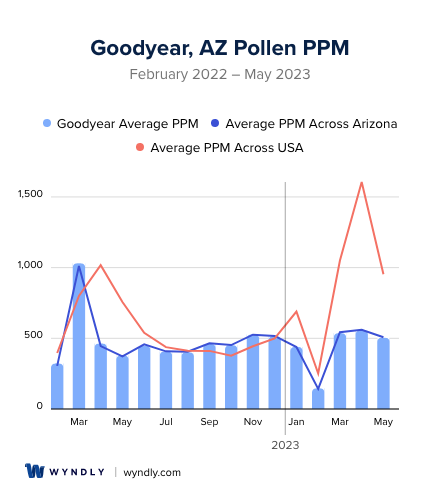
Goodyear, AZ Pollen and Allergy Breakdown by Month
Grass
When is grass pollen highest in Goodyear, AZ?
May has the highest grass pollen in Goodyear, AZ with an average PPM of
When is grass pollen lowest in Goodyear, AZ?
December has the lowest grass pollen in Goodyear, AZ with an average PPM of
Tree
When is tree pollen highest in Goodyear, AZ?
March has the highest tree pollen in Goodyear, AZ with an average PPM of
When is tree pollen lowest in Goodyear, AZ?
July has the lowest tree pollen in Goodyear, AZ with an average PPM of
Weed
When is weed pollen highest in Goodyear, AZ?
November has the highest weed pollen in Goodyear, AZ with an average PPM of
When is weed pollen lowest in Goodyear, AZ?
February has the lowest weed pollen in Goodyear, AZ with an average PPM of
Goodyear, AZ Pollen Monthly Breakdown by Pollen Type

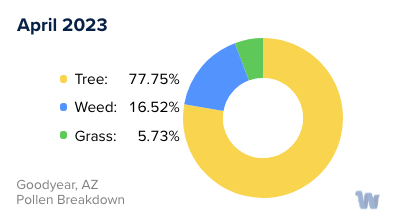


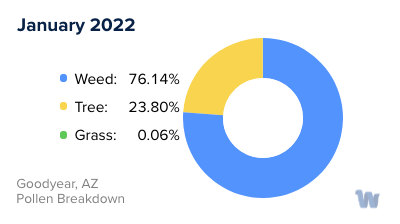
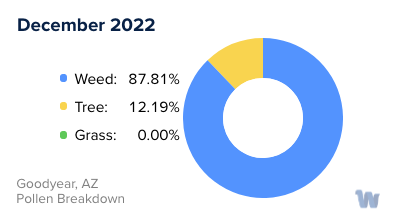

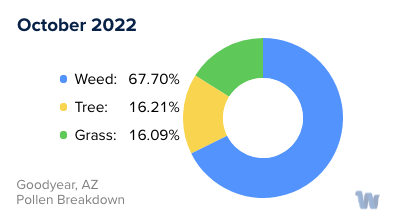



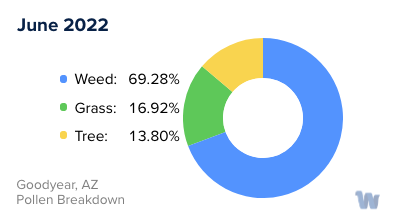
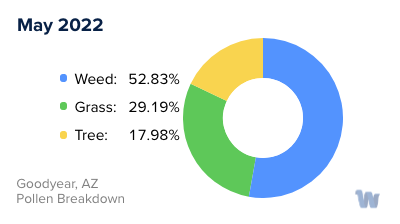



Pollen and Hay Fever in Goodyear, AZ
Pollen allergies, commonly known as hay fever, can be a significant issue for residents of Goodyear, Arizona. The pollen count, a measure of pollen density in the air, can fluctuate greatly from day to day, contributing to the overall allergy risk. The most prevalent types of pollen found in Goodyear include tree pollen, grass pollen, and ragweed pollen.
Tree pollen in Goodyear often shows a low presence, but this doesn't mean that it can't affect those who are especially sensitive to it. It's important to note that a low overall pollen count doesn't necessarily equate to a low risk of symptoms, as individual types of pollen, such as tree pollen, can still be present in significant amounts.
Grass pollen, on the other hand, frequently presents at high levels in the local environment. This can pose a considerable challenge for those with sensitivities or allergies to this type of pollen.
Ragweed pollen varies, sometimes showing moderate levels, while at other times, it's virtually non-existent. But when present, it can cause a variety of allergy symptoms, from sneezing and itching to more severe reactions.
The climate of Goodyear, part of the broader Arizona region, makes it a unique location for pollen allergies. Due to the dry and warm climate, the allergy season in Arizona can last year-round, unlike in many other regions where it is limited to specific seasons. This means that residents could potentially experience allergy symptoms at any time of the year.
Grass pollen in Arizona is mainly produced during the summer months, while weeds, which can also produce allergenic pollen, primarily do so in the fall and may continue into the winter. Tree pollen can be encountered in both the winter and spring. The months of April, May, and September are typically when seasonal allergies peak in Arizona, and during these months, pollen counts can be particularly high.
It's also important to note that even in winter, a typically mild season in Arizona, residents might not get a break from their seasonal allergies. For example, Juniper trees, one of the common allergens in Arizona, produce pollen in the winter and can cause issues for many residents.
Therefore, for those living in Goodyear, staying informed about the local pollen count and being aware of the types of pollen present in the environment can be an essential part of managing their allergies. Despite the challenges, understanding the local pollen seasons and types can help residents better navigate their daily lives while dealing with pollen allergies.


